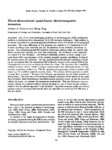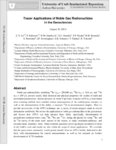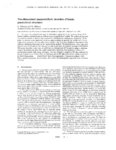Filters: Department: "Geology & Geophysics" School Or College: "College of Mines & Earth Sciences" Collection: "ir_uspace"
| Creator | Title | Description | Subject | Date | ||
|---|---|---|---|---|---|---|
| 76 |
 |
Zhdanov, Michael | Resistivity imaging by time domain electromagnetic migration (TDEMM) | One of the most challenging problems of electrical geophysical methods is the interpretation of time domain electromagnetic (TDEM) sounding data in the areas with the horizontally inhomogeneous geoelectrical structures. This problem is of utmost importance in mining exploration and environmental stu... | 1995 | |
| 77 |
 |
Jarrard, Richard D. | Resistivity/porosity/velocity relationships from downhole logs: an aid for evaluating pore morphology | Relationships between downhole resistivity/velocity logs and porosity styles, controlled by cementation/dissolution/recrystallization, are investigated using core and downhole logging data from the carbonate-rich sediments encountered during Leg 133 of the Ocean Drilling Program (ODP), northeastern ... | 1993 | |
| 78 |
 |
Jarrard, Richard D. | Results of borehole televiewer observations in the Celebes and Sulu Seas | Borehole televiewer data were collected during Ocean Drilling Program Leg 124 to investigate stress orientations in the Sulu and Celebes sea basins. At Site 768C, in the Sulu Sea, televiewer logs were collected from 809-870 and 950-1250 meters below sea floor (mbsf). At Site 770C, in the Celebes Se... | 1991 | |
| 79 |
 |
Zhdanov, Michael S. | Rigorous 3D inversion of marine CSEM data based on the integral equation method | Marine controlled-source electromagnetic (MCSEM) surveys have become an important part of offshore petroleum exploration. However, due to enormous computational difficulties with full 3D inversion, practical interpretation of MCSEM data is still a very challenging problem. We present a new approach ... | 2007 | |
| 80 |
 |
Jarrard, Richard D. | Scientific methods: an online book | This book was originally intended as ˜How to do science™, or ˜How to be a scientist™, providing guidance for the new scientist, as well as some reminders and tips for experienced researchers. Such a book does not need to be written by the most expert or most famous scientist, but by one who... | Science; Process; Method | 2001 |
| 81 |
 |
Jarrard, Richard D. | Sedimentary response to paleoclimate from downhole logs at Site 693, Antarctic Continental Margin | The first well logs collected below the Antarctic circle were obtained during Leg 113 at Site 693 on the Dronning Maud Land Margin (Antarctica) in the Weddell Sea. Gamma-ray, resistivity, and sonic logs were collected between 108.0 and 439.0 mbsf. The downhole logs show good agreement with the data... | 1990 | |
| 82 |
 |
Jarrard, Richard D. | Sedimentology and downhole log analysis of Site 820, central Great Barrier Reef outer shelf: the factors controlling Pleistocene progradational and aggradational seismic geometry | The textural and compositional characteristics of the 400 m sequence of Pleistocene wackestones and packstones intersected at Ocean Drilling Program (ODP) Site 820 reflect deposition controlled by fluctuations in sea-level, and by variations in the rate of sediment supply. The development of an effe... | 1993 | |
| 83 |
 |
Jarrard, Richard D. | Seismic stratigraphy and history of deep circulation and sediment drift development in Baffin Bay and the Labrador Sea | Drilling results and seismic-reflection records at and across Ocean Drilling Program (ODP) Sites 645 (western Baffin Bay), 646, and 647 (Labrador Sea) provide important constraints on the history of deep-water circulation and sedimentation in response to Cenozoic climatic change, as well as the tect... | 1989 | |
| 84 |
 |
Chapman, David S.; Harris, Robert N. | Snow and the ground temperature record of climate change | Borehole temperature-depth profiles contain a record of surface ground temperature (SGT) changes with time and complement surface air temperature (SAT) analysis to infer climate change over multiple centuries. Ground temperatures are generally warmer than air temperatures due to solar radiation effe... | Snow cover; Snow modeling; land/atmosphere interactions; Borehole climate reconstructions; Surface air temperature; Ground surface temperature; Borehole temperatures; Geothermal observations; Heat transfer | 2002 |
| 85 |
 |
Brown, Francis Harold | Some early pleistocene deposits of the lower Omo valley: the Usno formation | Early Pleistocene deposits of the Rudolf Basin have been described by E. Brumpt (Bourg de Bozas, 1903: 107 ff.), Arambourg (1943: 190 ff.), Fuchs (1939), Patterson (1966), and Butzer and Thurber (1969). These include the Omo Beds, first recognized by Brumpt in 1902 and subsequently studied by Arambo... | 1969 | |
| 86 |
 |
Chapman, David S.; Harris, Robert N. | Stop-go temperature logging for precision applications | We describe a new field procedure for stop-go temperature logging of boreholes that attains millikelvin precision. Temperature is recorded continuously throughout the entire log, but the logging probe is held stationary for a fixed time at discrete depth intervals. Equilibrium temperatures at the di... | Temperature logging; Boreholes; Stop-go logging method | 2007 |
| 87 |
 |
Chapman, David S. | Techniques, analysis, and noise in a Salt Lake Valley 4D gravity experiment | Repeated high-precision gravity measurements using an automated gravimeter and analysis of time series of 1-Hz samples allowed gravity measurements to be made with an accuracy of 5 μGal or better. Nonlinear instrument drift was removed using a new empirical staircase function built from multiple ... | Gravity measurements | 2008 |
| 88 |
 |
Chapman, David S. | Thermal analysis of the southern Powder River Basin, Wyoming | Temperature and geologic data from over 3000 oil and gas wells within a 180 km x 30 km area that transect across the southern Powder River Basin in Wyoming, U.S.A., were used to determine the present thermal regime of the basin. Three-dimensional temperature fields within the transect, based on... | Thermal analysis; Inversion; Bottom hole temperature | 1996-11 |
| 89 |
 |
Zhdanov, Michael | Three-dimensional inversion of large-scale EarthScope magnetotelluric data based on the integral equation method: geoelectrical imaging of the Yellowstone conductive mantle plume | Interpretation of the EarthScope MT (magnetotelluric) data requires the development of a large-scale inversion method which can address two common problems of 3D MT inversion: computational time and memory requirements. We have developed an efficient method of 3D MT inversion based on an IE (integ... | 2011 | |
| 90 |
 |
Zhdanov, Michael | Three-dimensional quasi linear electromagnetic inversion | One of the most challenging problems of electromagnetic (EM) geophysical methods is developing three-dimension(a3l- D) EM inversion techniques. This problem is of utmost importance in practical applications because of the 3-D nature of the geological structures.T he main difficulties in 3-D inversio... | 1996-01-01 | |
| 91 |
 |
Zhdanov, Michael S. | Three-dimensional quasi-linear electromagnetic modeling and inversion | The quasi-linear (QL) approximation replaces the (unknown) total field in the integral equation of electromagnetic (EM) scattering with a linear transformation of the primary field. This transformation involves the product of the primary field with a reflectivity tensor, which is assumed to vary slo... | 1999-01-01 | |
| 92 |
 |
Zhdanov, Michael S. | Three-dimensional regularized focusing inversion of gravity gradient tensor component data | We develop a new method for interpretation of tensor gravity field component data, based on regularized focusing inversion. The focusing inversion makes its possible to reconstruct a sharper image of the geological target than conventional maximum smoothness inversion. This new technique can be eff... | Focusing inversion; Gravity gradient; Gravity gradiometry | 2004 |
| 93 |
 |
Brown, Francis Harold | Timing of volcanism and evolution of the northern Kenya Rift | The northern Kenya Rift is bounded on the west by uplands of Turkana which comprise horst-like blocks that include metamorphic basement rocks, locally overlain unconformably by the Cretaceous Lubur Sandstone, in turn overlain by predominantly volcanic sequences in which relatively thin sedimentary p... | 2009 | |
| 94 |
 |
Hu, Lihai | Trace elements in the hair | Study of uneven distribution of trace elements in elephant hair and compare the result with animal horns. | 2013 | |
| 95 |
 |
Solomon, Douglas Kip | Tracer applications of noble gas radionuclides in the geosciences | Noble gas radionuclides, including 81Kr (t1/2 = 229,000 yr), 85Kr (t1/2 = 10.8 yr), and 39Ar (t1/2 = 269 yr), possess nearly ideal chemical and physical properties for studies of earth and environmental processes. Recent advances in Atom Trap Trace Analysis (ATTA), a laser-based atom counting method... | 2014-01-01 | |
| 96 |
 |
Zhdanov, Michael | Two-dimensional magnetotelluric inversion of blocky geoelectrical structures | This paper demonstrates that there are alternative approaches to the magnetotelluric (MT) inverse problem solution based on different types of geoelectrical models. The traditional approach uses smooth models to describe the conductivity distribution in underground formations. In this paper, we pres... | 2002-01-01 | |
| 97 |
 |
Zhdanov, Michael S. | Underground imaging by frequency-domain electromagnetic migration | A new method of the resistivity imaging based on frequency-domain electromagnetic migration is developed. Electromagnetic (EM) migration involves downward diffusion of observed EM fields whose time flow has been reversed. Unlike downward analytical continuation, migration is a stable procedure tha... | 1996-01-01 | |
| 98 |
 |
Jarrard, Richard D. | Velocity and density of carbonate-rich sediments from northeastern Australian margin: integration of core and log data | During Ocean Drilling Program (ODP) Leg 133, shipboard scientists obtained a remarkable quantity of both core and log measurements of the physical properties of carbonate-rich sediments. This suite of measurements provides a unique opportunity to evaluate the robustness of each measurement technique... | 1993 | |
| 99 |
 |
Jarrard, Richard D. | Velocity and density of sediments of Eirik Ridge, Labrador Sea: control by porosity and mineralogy | A 767-m section of late Neogene (0-8 Ma) terrigenous sediments was cored at Ocean Drilling Program (ODP) Site 646. Continuous downhole geophysical logs, 161 laboratory measurements of core porosity and density, and 63 laboratory measurements of core velocity are used to analyze in detail the effects... | 1989 | |
| 100 |
 |
Thorne, Michael S. | Viterbi sparse spike detection | Accurate interpretation of seismic traveltimes and amplitudes in the exploration and global scales is complicated by the band-limited nature of seismic data. We discovered a stochastic method to reduce a seismic waveform into a most probable constituent spike train. Model waveforms were constructed ... | 2013-01-01 |
